By Kyle Orton (@KyleWOrton) on August 30, 2016
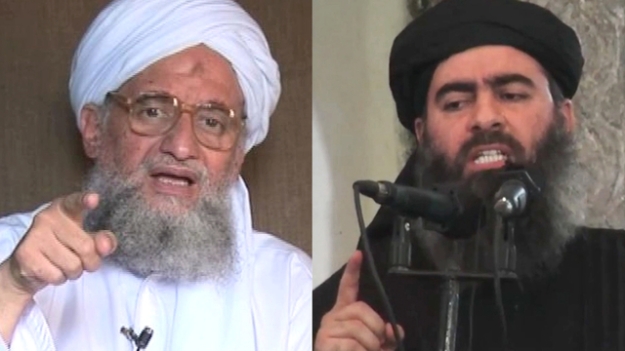
Since al-Qaeda broke ties with the Islamic State (IS), then the Islamic State of Iraq and Syria (ISIS), in 2014 there has been an ongoing war of narratives about what happened. Below is an attempt to work through this murky situation.
Early Days
Ahmad al-Khalayleh (Abu Musab al-Zarqawi) set up the organization now known as IS in Taliban Afghanistan in 2000, using al-Qaeda seed money. The organization was then-called Jund al-Sham. Al-Khalayleh departed to Iran once the Taliban was ousted, and moved into an enclave of northern Iraq held by Ansar al-Islam—really a precursor jihadi statelet to IS’s, on five-hundred-square-kilometres of territory, ruling over 200,000 people. Arriving in April 2002, al-Khalayleh orchestrated the assassination attempt against Barham Salih, the Prime Minister of Iraqi Kurdistan.
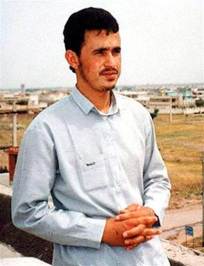
Ahmad al-Khalayleh, long before he was Abu Musab al-Zarqawi
By May 2002, al-Khalayleh was in Baghdad, with “a dozen” senior al-Qaeda linked operatives, including the Egyptian Thirwat Shehata, who spent time with al-Qaeda in post-Qaddafi Libya until he was reportedly arrested in 2014, and his brother-in-law and fellow Jordanian, Iyad al-Tubaysi (Abu Julaybib). They were joined by al-Khalayleh’s Egyptian successor, Abd al-Munim al-Badawi (Abu Hamza al-Muhajir), who appears to have already been in the country, and later by Samir Hijazi (Abu Hammam al-Suri, Farouq al-Suri). Interestingly, al-Tubaysi was also among the seven-man team that IS dispatched into Syria to create Jabhat al-Nusra in 2011, and al-Tubaysi and Hijazi are among those who have objected to al-Nusra’s rebranding as Jabhat Fatah al-Sham (JFS) and ostensibly split from the organization.
Saddam Hussein’s government gave various kinds of support to Ansar al-Islam—they kept his chief foe, the Kurds, off-balance after all—and Saddam was certainly (p. 338) “at a minimum” aware of al-Khalayleh’s presence in his capital because Amman gave “detailed information about al-Zarqawi’s possible location” as early as June 2002. Instead of rounding him up, al-Khalayleh was allowed “relatively free” movement within central Iraq. Contrary to some recent comments from those contending to lead the free world, Saddam’s opposition to terrorism was not one of his notable characteristics.
Al-Khalayleh departed Iraq on a recruitment drive in the Levant around July 2002, to Ayn al-Hilweh in southern Lebanon (where he made associations with Asbat al-Ansar, which was connected to Assad’s mukhabarat, as well as to al-Qaeda) and then Syria, where he organized the “ratlines” that—overseen by Assad’s intelligence—brought the foreign mujahideen into Iraq during the invasion and long after. While in Syria, in collaboration (p. 17) with Assadist cut-outs, al-Khalayleh organized the assassination of USAID’s Laurence Foley on 28 October 2002.
Al-Khalayleh moved back to Baghdad and departed for the final time while Saddam was in power in November 2002 (p. 91), perhaps because a second request had now been forwarded to Saddam’s regime to apprehend al-Khalayleh, again from the Jordanians, this time at the behest of the Americans in relation to the Foley murder. Al-Khalayleh returned to Ansar-held territory in northern Iraq and fled with several hundred men into Iran on 29 March 2003 during the invasion.
After the Iraq Invasion
Ansar and associated forces were smuggled back into Iraq with the complicity of the Iranian government and the fallen Saddam regime around early June 2003. Once back in Iraq, Ansar would reassert its autonomy—until joining IS in August 2014. Al-Khalayleh’s network coalesced into Jamaat al-Tawhid wal-Jihad (JTJ). Able to call on a large underground Salafist network, with deep links to the Saddam regime’s security apparatus, which had been both allowed to develop as Saddam’s regime Islamized and which the regime lost the capacity to restrain, JTJ’s media apparatus lagged its military capacity. It is therefore unclear when exactly JTJ became a declared entity.
The trio of “spectacular” bombings that started it all in August 2003—against the Jordanian Embassy in Baghdad, the United Nations at the Canal Hotel, specifically intended to murder Sergio de Mello, who had “extracted a part of the Islamic land” (East Timor), and against a Shi’a mosque in Najaf, killing Ayatollah Mohammad Baqir al-Hakim—were only claimed by al-Khalayleh on 6 April 2004. The rebranded Ansar al-Islam (Ansar al-Sunna) was announced on 20 September 2003; JTJ was probably formed within a month of that date.
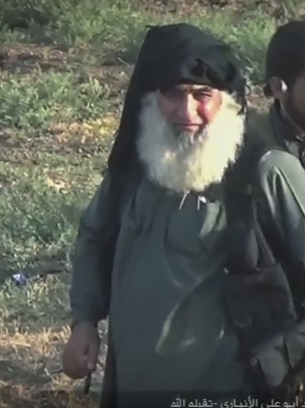
Abd al-Rahman al-Qaduli (Abu Ali al-Anbari)
Al-Khalayleh gave his bayat (pledge of allegiance) to al-Qaeda in October 2004, and it was accepted by Usama bin Ladin in December 2004. JTJ became al-Qaeda in Mesopotamia (AQM).
AQM was foreign-led initially but a process of “Iraqization” was well underway by the time al-Khalayleh was killed in June 2006, with al-Majlis Shura al-Mujahideen (MSM) formed in January 2006 from AQM and five other groups, ostensibly led by one Abdullah bin Rashid al-Baghdadi, who according to IS was Abd al-Rahman al-Qaduli (Abu Ali al-Anbari). With al-Khalayleh dead and al-Qaduli in prison, al-Badawi became emir of both AQM and the ostensible-coalition of MSM.
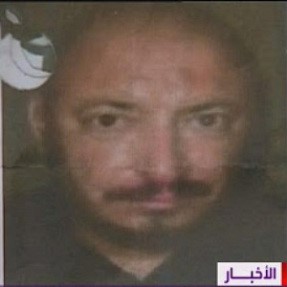
Hamid al-Zawi (Abu Umar al-Baghdadi)
On 12 October 2006, three additional Islamist groups and six Anbari tribes (of thirty-one) took Hilf al-Mutayibeen (Oath of the Scented Ones), merging with MSM. Three days later the Islamic State of Iraq (ISI) was declared under the leadership of Hamid al-Zawi (Abu Umar al-Baghdadi), a stolid bureaucrat and consensus figure within AQM, a stark contrast to the charismatic al-Khalayleh. On 10 November 2006, in a speech entitled, “Judgment is for None but Allah,” al-Badawi switched his bayat to al-Zawi and said the 12,000 soldiers of MSM were now at the service of ISI, technically dissolving al-Qaeda on Iraqi territory. And here things get murky.
The Dispute
In the telling of IS(IS), the declaration of ISI meant they were now a state, unaffiliated to al-Qaeda, and they point to statements by Ayman al-Zawahiri, including one in December 2007 where al-Zawahiri said: “There isn’t anything today in Iraq named ‘al-Qaeda’,” and another in April 2008, where al-Zawahiri said ISI, the “Islamic Emirate” (Taliban), and Imarat Kavkaz as “individual Islamic emirates that do not yield to a single ruler”, i.e. ISI was not under Bin Laden’s command. Al-Qaeda, however, says that ISI was merely a group with the name “Islamic State” and both al-Zawi and his successor, Ibrahim al-Badri (Abu Bakr al-Baghdadi), remained al-Qalim (location leader) in Iraq for al-Qaeda, until al-Qaeda broke connections with IS on 3 February 2014. There seems to have been a degree of willed ambiguity on all sides.
While it is true that IS regularly defied al-Qaeda by, for example, attacking Shi’a civilians—the letters from al-Zawahiri and Jamal al-Misrati (Atiya) in 2005 criticizing al-Khalayleh are famous—which is held by IS to show they were independent, it is also true, as Taha Falaha (Abu Muhammad al-Adnani) once put it, that ISI kept “abiding by the advices and directives of” al-Qaeda, specifically on not attacking Iran, where al-Qaeda maintains its key resource pipeline to this day. “Let history record that Iran owes an invaluable debt to al-Qaeda,” Falaha had tauntingly added.[1]
Falaha’s statement came in response to a May 2014 speech by al-Zawahiri, where he claimed that al-Badawi had sent a letter to al-Qaeda “central” (AQC) after ISI was established giving his bayat, and that of al-Zawi, to Bin Ladin. This was kept secret due to “political considerations”. After al-Badri became leader an ISI Shura Council member wrote to AQC and al-Zawahiri quotes the letter saying that ISI had tried to wait for AQC’s instructions on appointing the next leader but “for several reasons” had been unable to. Al-Badri’s appointment, however, should only be considered “temporary” and “if anyone is sent from you” ISI will “ensure” that he takes over the leadership, al-Zawahiri quotes the ISI letter saying.
After Bin Ladin was killed, al-Badri made a public statement that al-Zawahiri had “faithful men in the Islamic State of Iraq”. In August 2011, Falaha’s inaugural speech as ISI spokesman publicly welcomed al-Zawahiri’s appointment as al-Qaeda leader, following the pattern of a series of statements from al-Qaeda’s other branches in Yemen, North Africa, and Somalia. Al-Zawahiri quotes a letter from ISI to Atiya in May 2011, which asked, “Do we renew the baya in public or in secret as it was done before?”
Al-Zawahiri’s speech contained references to internal al-Qaeda memos, some of them made public after the Abbottabad raid. Perhaps this was skilful disinformation. A more likely explanation is that al-Qaeda sincerely believed it was in command of ISI. The evidence of a direct, secret pledge of allegiance from ISI to al-Qaeda is absent, though such a thing is plausible. There is also independent evidence that is suggestive of a continued relationship—whatever the formalities—after the statehood declaration.
The key AQM/ISI link to AQC, Mustafa Haji Khan (Hassan Ghul), had been arrested in February 2004 in possession of al-Khalayleh’s letter laying out his plan for sectarian war. Al-Qaduli had served as AQI/ISI representative to AQC until his arrest in early 2006. AQC sent a senior figure, Nashwan Abd al-Baqi (Abd al-Hadi al-Iraqi), to Iraq to try to restore their line of communication, but he was arrested in late 2006. The next intermediary, Khalid al-Mashadani (Abu Muhammad al-Mashadani), who also served as media emir, was arrested in July 2007. When the Coalition captured the famous series of letters from AQC to ISI in late 2007 and early 2008, related to the complaints registered against ISI by Abu Sulayman al-Utaybi, it is not clear that ISI’s leaders had seen all of them, though it does appear al-Badawi had written one, brief response.[2] Al-Badri was unknown to Bin Ladin when he became emir in May 2010. The U.S. said in June 2010 that it believed communication between ISI and AQC had been “broken”; an internal assessment from al-Qaeda, by the American media operative Adam Gadahn, said that communication with ISI had been “practically cut off for a number of years” by January 2011. Three months later, Bin Laden himself remarked on the “scarcity” of communications from Iraq. It is unclear if al-Badri communicated at all with al-Qaeda until al-Qaduli came out of prison in 2012, despite al-Zawahiri’s claim to the contrary. This communications breakdown would argue in ISI’s favour that it was its own independent entity. But, even if al-Zawahiri is lying when he quotes letters from Falaha (March/April 2013) and al-Badri (July/August 2013), during the ISI-al-Nusra schism, which purportedly refer to al-Zawahiri as “our leader,” it is nonetheless true that al-Badri did accept—until the decision went against him—that al-Qaeda was the legitimate authority to rule on the dispute between ISI and al-Nusra. This suggests it was a common understanding between ISI and AQC that al-Zawahiri was the emir.
Additionally suggestive of ISI being a branch of al-Qaeda: the Iran-based al-Qaeda network, led by Ezedin Abdel Aziz Khalil (Yasin al-Suri) and for a time Muhsin al-Fadhli of later “Khorasan Group” fame, was also providing ISI with resources at least as late as 2009.
It’s open to doubt what practical impact ISI’s bayat to al-Qaeda had. It was evidently politically toxic within Iraq to such an extent that they denied it; Falaha was not lying when he said that ISI had conducted itself without reference to, and often in defiance of, AQC; and in terms of resources ISI was self-sufficient. Al-Zawahiri’s July 2005 letter included a request that ISI send AQC a “payment” of $100,000.
ISI’s subordination to AQC might have been largely an abstraction, but it does seem that this was the way all sides understood the relationship.
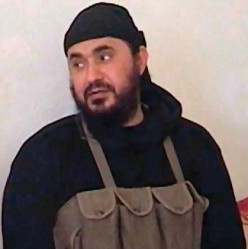
Ahmad al-Khalayleh in his first public appearance as Abu Musab al-Zarqawi, April 2006
Al-Qaeda’s attempt to avoid blame for ISI’s mistakes led it to rather shade the truth on ISI’s behaviour. Al-Qaeda claims that ISI was its Iraqi branch until 2014 but its state-building pretentions violated the group’s methods. Al-Zawahiri has said publicly that ISI’s announcement was done without al-Qaeda’s knowledge. Al-Qaeda was “not informed about [the state’s] creation,” al-Zawahiri said in his note expelling then-ISIS, and he repeated this in May 2014. Adam Gadahn’s January 2011 letter, which advised Bin Ladin to publicly break with ISI, lambasted their “fictitious state,” and claimed ISI was formed “without an order from al-Qaeda and without consultation”. But this isn’t quite true. What al-Qaeda was uninformed of was the timing of the state declaration.
In Iran, in late 2001, al-Khalayleh was with Sayf al-Adel, one of al-Qaeda’s chief military and strategic leaders to this day, and they formulated (p. 15-16) a plan to create an embryo caliphate in Iraq. Al-Adel reiterated this plan to al-Khalayleh in a letter in 2005, and the above-mentioned letters form al-Zawahiri and Atiya that year, while partially rebuking al-Khalayleh, were on-board with a state-building project. In the April 2006 video where al-Khalayleh showed his face, he said MSM was “the starting point for establishing an Islamic state,” and in unbroadcast footage said he wanted to do this within three months. (He was killed within two.)
Conclusion
Thus, ISI really had attempted to build a proto-caliphate in Iraq—it just had al-Qaeda’s blessing for the idea, even if not for all of the methods used to try to get there, and the coordination of its announcement had been a big ragged.
The argument, therefore, of Hassan Hassan and Bassam Barabandi, that al-Qaeda’s move with JFS—effectively an information operation, albeit with real-world effects—is a replay of what happened with MSM is convincing. Al-Zawahiri wrote to al-Khalayleh after MSM was declared:
My belief has always been that Islam’s victory at this day and age will be reached through the establishment of a Muslim country on the methodology of the Prophet in the heartlands of the Islamic world. … [W]e expect your state to be formed … and … with God’s help, [it] shall be a broad step in the direct path toward [a globe-spanning caliphate].
Later, as al-Qaeda changed its own view, it would deny that “state-now” was ever any part of its methodology, and IS(IS) would claim that the public relations was for real.
* * * * *
NOTES
[1] Update: One of the files from Abbottabad, the “Letter to Karim”, shows Usama bin Ladin writing to someone in the Islamic State of Iraq using that pseudonym. It is not absolutely clear who the letter is to, though it is most likely directed to Abdul Munim al-Badawi (Abu Hamza al-Muhajir), the ISI deputy. Dated 18 October 2007, the letter reprimands the recipient for a verbal attack against Iran. “You know that Iran is our main artery for funds, personnel, and communication, as well as for the matter of hostages,” Bin Ladin wrote. This tallies with U.S. government reports that al-Qaeda has its “core facilitation pipeline” running through Iran under a “secret deal” with the theocracy.
[2] Update: The “Letter to Karim”, assuming “Karim” is al-Badawi, would confirm that al-Badawi wrote to Bin Ladin in the 2007. Bin Ladin is clearly dissatisfied, writing that the “message … ended abruptly without an ending, signature, and date. I wonder what the cause was for this error”.
* * * * *
POSTSCRIPT
For fuller details on the various stages of the schism between al-Qaeda and the Islamic State, see:
- April 8, 2013: IS leader Abu Bakr al-Baghdadi releases a speech publicly admitting that Jabhat al-Nusra was set up as the Syrian front of the then-Islamic State of Iraq (ISI), and he now claims authority over it, merging ISI and al-Nusra into the Islamic State of Iraq and Syria (ISIS).
- April 10, 2013: Al-Nusra’s leader, Abu Muhammad al-Jolani, responds to al-Baghdadi’s declaration of ISIS by rejecting the merger and swearing allegiance directly to al-Qaeda.
- June 9, 2013: The ruling of al-Qaeda’s leader, Ayman al-Zawahiri, is made public: the letter, dated 23 May 2013, says ISIS is to be dissolved, al-Baghdadi is to return his troops to Iraq where he will work as the Iraqi branch of al-Qaeda under the ISI name, and al-Nusra is to be a standalone branch of al-Qaeda in Syria.
- June 14, 2013: Al-Baghdadi rejected al-Zawahiri’s ruling in a speech simply entitled, “Remaining in Iraq and Syria“.
- June 19, 2013: Where al-Baghdadi had maintained a respectful tone—despite one or two jibes—when addressing al-Zawahiri, then-ISIS’s official spokesman Abu Muhammad al-Adnani cast aside this formality and savaged al-Zawahiri as a man leading the religion astray, promoting sin and division among Muslims by upholding the infidel borders of Sykes-Picot and siding with a renegade (al-Jolani).
- February 3, 2014: After months of efforts to promote reconciliation by al-Qaeda failed to stem a rising tide of intra-jihadi conflict in Syria between al-Nusra and ISIS, al-Zawahiri formally expelled ISIS from al-Qaeda’s ranks.
- April 17, 2014: In ISIS’s most fierce statement to date, al-Adnani attacked al-Zawahiri in a speech as having deviated from al-Qaeda’s original path under Usama bin Ladin, siding with disbelievers (i.e. the nationalist insurgents in Syria), and dividing the Muslims based on borders drawn by Christian colonialists and the rebellious actions of the treacherous al-Jolani.
- May 3, 2014: Al-Zawahiri issued his first important response to the jihadist fratricide in Syria, which was essentially a data dump of documentation—some of it traceable from captured material in Bin Ladin’s hideout—that assaulted the pillars of ISIS’s case for its actions, particularly that it had never actually under al-Qaeda’s authority and thus had not engaged in the disobedience of which it now accused al-Nusra.
- May 11, 2014: Responding to al-Zawahiri’s statement, al-Adnani claimed that al-Qaeda’s leader “strove hard to prove” something that he “did not prove nor shall he ever prove,” namely that ISIS had been al-Qaeda’s Iraqi branch. Al-Adnani’s statement was ferocious in its condemnation of al-Zawahiri as a splitter of ranks of the jihadists and a religious deviant, and even attacked al-Zawahiri personally, referring to him as “senile” at one point.
- 2015: Various details about how the schism evolved leaked out, particularly surrounding the orchestration of events by al-Baghdadi’s deputy, Samir al-Khlifawi (Haji Bakr), a former member of Saddam Husayn’s intelligence services, who oversaw IS’s affairs in Syria.
- August 2016: IS released an official biography for Abdurrahman al-Qaduli, the caliph’s then-recently-deceased deputy. Al-Qaduli is one of the most important figures in the history of the IS movement, a long-time al-Qaeda operative who had been in an Iraqi jail between 2006 and 2012. Al-Qaduli took over the Syria file after al-Khlifawi was killed by the Syrian opposition, and the biography essentially gives IS’s side of the dispute—that al-Nusra conspired with al-Qaeda to rebel against them and break a legitimate oath.
- November 20, 2016: Al-Nusra released its first official explanation of how it split from its parent organization. Abdelraheem Atoun (Abu Abdullah al-Shami), the general shar’i of al-Nusra, made the case that al-Nusra had raised complaints about the conduct of al-Baghdadi to his superior, al-Zawahiri, and al-Baghdadi “considered it a defection” and initiated hostilities to take over al-Nusra, which they resisted. Atoun detailed IS’s attempt to maintain control over al-Nusra by dispatching senior deputies into Syria, specifically al-Adnani and al-Qaduli.
Pingback: Obituary: Taha Falaha (Abu Muhammad al-Adnani) | The Syrian Intifada
Pingback: Fifteen Years After 9/11 | The Syrian Intifada
Pingback: The Obama Admin Has Officially Forgiven Iran - The DENISE SIMON EXPERIENCE Blog
Pingback: The Obama Admin Has Officially Forgiven Iran - #RedNationRising
Pingback: The Riddle of Haji Bakr | The Syrian Intifada
Pingback: The Islamic State and Chemical Weapons | The Syrian Intifada
Pingback: Al-Qaeda Explains its Split with the Islamic State | The Syrian Intifada
Pingback: The Islamic State’s Official Biography of the Caliph’s Deputy | The Syrian Intifada
Pingback: How the Islamic State’s Caliph Responded to Defeat Last Time | The Syrian Intifada
Pingback: The Coalition Strikes Down Al-Qaeda’s Leaders In Syria | The Syrian Intifada
Pingback: The Islamic State’s First War Minister | The Syrian Intifada
Pingback: The Islamic State Was Winning When We Thought It Was Losing | The Syrian Intifada
Pingback: Analysis: ‘Signs of Recovery for the Islamic State’ | The Counter Jihad Report
Pingback: Jihadi Clerics Dispute Legitimacy of Hay’at Tahrir al-Sham | The Syrian Intifada
Pingback: Jihadi Cleric Calls for Al-Qaeda’s Leader in Syria To Be Put on Trial | The Syrian Intifada
Pingback: The Coalition’s Partner in Syria: The Syrian Democratic Forces | The Syrian Intifada
Pingback: Obituary: Abd al-Rahman Mustafa al-Qaduli (Abu Ali al-Anbari) | The Syrian Intifada
Pingback: The Islamic State’s Obituary for Abu Ayman al-Iraqi | The Syrian Intifada
Pingback: How the Islamic State’s Founder Justifies Murdering Shi’a Civilians | The Syrian Intifada
Pingback: The Islamic State Planned For Sectarian War in Iraq From the Beginning | The Syrian Intifada
Pingback: Al-Qaeda Instructs the Islamic State’s Predecessor Not to Attack Iran | The Syrian Intifada
Pingback: The Official Declaration that Made Abu Bakr al-Baghdadi Leader of the Islamic State | The Syrian Intifada
Pingback: The Continuing Syrian Efforts to Resist Jihadism | The Syrian Intifada
Pingback: Islamic State’s First Leader Denies He Has Been Captured, West Wonders If He Exists | The Syrian Intifada
Pingback: U.S. Treasury Targets Al-Qaeda in Syria | The Syrian Intifada
Pingback: The Islamic State’s Media Apparatus and its New Spokesman | The Syrian Intifada
Pingback: Russia Moves in For the Kill in Syria | The Syrian Intifada
Pingback: Activist Group Lists Ten Most Important Islamic State Leaders Killed | The Syrian Intifada
Pingback: Senior Islamic State Cleric Turki al-Binali Killed in an Airstrike | The Syrian Intifada
Pingback: The Mosul Operation and Saddam’s Long Shadow | The Syrian Intifada
Pingback: An Ideological Founder of Islamic State is Killed in Syria | The Syrian Intifada
Pingback: Signs of Recovery for the Islamic State | The Syrian Intifada
Pingback: America Sanctions Operatives of the Islamic State’s Chemical Weapons Department | The Syrian Intifada
Pingback: Coalition Targets Islamic State Recruiters and Terrorism Planners | The Syrian Intifada
Pingback: Al-Qaeda Letter on Relations with the Islamic State and Iran | The Syrian Intifada
Pingback: Why The Islamic State Endures | The Syrian Intifada
Pingback: The End of the Line for “The Beatles” of the Islamic State | The Syrian Intifada
Pingback: Al-Qaeda Leader Profiles the Founder of the Islamic State | The Syrian Intifada
Pingback: Islamic State Recommends More Gentleness in Dealing With Sinners | The Syrian Intifada
Pingback: The Announcement of the Islamic State—in 2006 | The Syrian Intifada
Pingback: The Islamic State’s First Leader Explains How to Deal With Enemies | The Syrian Intifada
Pingback: The Coalition’s Partner in Syria: The Syrian Democratic Forces | Kyle Orton's Blog
Pingback: The End of the Line for “The Beatles” of the Islamic State | Kyle Orton's Blog
Pingback: Islamic State Profiles the Godfather of its Media Department | Kyle Orton's Blog
Pingback: The Coalition Strikes Down Al-Qaeda's Leaders In Syria | Kyle Orton's Blog
Pingback: An Ideological Founder of Islamic State is Killed in Syria - Kyle Orton's Blog
Pingback: Al-Qaeda Letter on Relations with the Islamic State and Iran - Kyle Orton's Blog
Pingback: Profile: First Spokesman of the Islamic State Movement - Kyle Orton's Blog